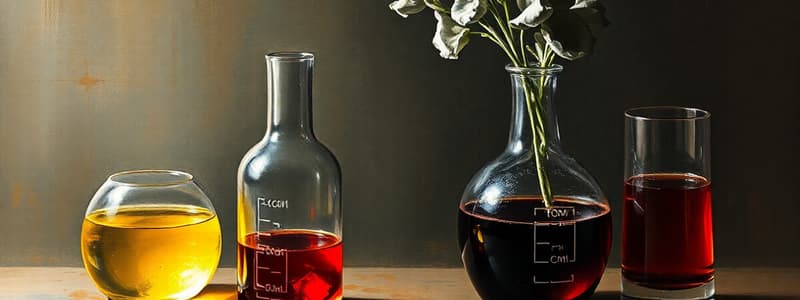Podcast
Questions and Answers
What does concentration measure in a solution?
What does concentration measure in a solution?
- The total volume of the solvent used
- The amount of solute dissolved in a given volume of solvent (correct)
- The temperature of the solution
- The pressure exerted by the solute
What is the purpose of placing a white tile under the conical flask during titration?
What is the purpose of placing a white tile under the conical flask during titration?
- To reduce the heating effect of the burette
- To absorb excess liquid spillage
- To prevent the flask from sliding
- To enhance the visibility of the color change (correct)
What does a concentrated solution imply about its solute?
What does a concentrated solution imply about its solute?
- The solute is evenly distributed throughout the solvent
- The solute is insoluble in the solvent
- There is a very small amount of solute present
- There is a high concentration of solute (correct)
What uncertainty is recorded when using a burette marked to a precision of 0.10 cm3?
What uncertainty is recorded when using a burette marked to a precision of 0.10 cm3?
What is the equivalence point in titration?
What is the equivalence point in titration?
What is the oxidation number of sulfur in S4O6^2-?
What is the oxidation number of sulfur in S4O6^2-?
What is the purpose of using Roman numerals in the notation of transition metals?
What is the purpose of using Roman numerals in the notation of transition metals?
Which of the following represents a redox reaction?
Which of the following represents a redox reaction?
Why can't single atoms have a fractional oxidation number?
Why can't single atoms have a fractional oxidation number?
What is produced when a metal reacts with an acid?
What is produced when a metal reacts with an acid?
What is true about strong acids when dissolved in water?
What is true about strong acids when dissolved in water?
Which statement describes weak acids?
Which statement describes weak acids?
When ethanoic acid (CH3COOH) is dissolved in water, what is the primary product?
When ethanoic acid (CH3COOH) is dissolved in water, what is the primary product?
How do weak bases behave when dissolved in solution?
How do weak bases behave when dissolved in solution?
What occurs during the dissociation of strong bases in solution?
What occurs during the dissociation of strong bases in solution?
Which of the following statements is incorrect regarding weak acids?
Which of the following statements is incorrect regarding weak acids?
What is the general reaction of a strong acid in solution?
What is the general reaction of a strong acid in solution?
Which of the following acids is an example of a weak acid?
Which of the following acids is an example of a weak acid?
What does the oxidation state of an atom represent?
What does the oxidation state of an atom represent?
In a neutral molecule, the sum of the oxidation numbers must equal what value?
In a neutral molecule, the sum of the oxidation numbers must equal what value?
Which of the following statements is true regarding oxidation numbers in a compound?
Which of the following statements is true regarding oxidation numbers in a compound?
How can oxidation numbers help in balancing redox equations?
How can oxidation numbers help in balancing redox equations?
Which of the following scenarios would result in an element having a negative oxidation number?
Which of the following scenarios would result in an element having a negative oxidation number?
What is the first step to determine the oxidation number of an atom in a molecule?
What is the first step to determine the oxidation number of an atom in a molecule?
What must happen for the oxidation number of an atom to be positive in a compound?
What must happen for the oxidation number of an atom to be positive in a compound?
When considering CO2, what can be inferred about the oxidation states of the atoms involved?
When considering CO2, what can be inferred about the oxidation states of the atoms involved?
What trend does electronegativity display across a period in the periodic table?
What trend does electronegativity display across a period in the periodic table?
Which element in P2O5 has the most negative oxidation number?
Which element in P2O5 has the most negative oxidation number?
How can the oxidation state of an atom in a compound typically be determined?
How can the oxidation state of an atom in a compound typically be determined?
In which compound does sulfur have an oxidation state that is not a whole number?
In which compound does sulfur have an oxidation state that is not a whole number?
What happens to electronegativity when moving down a group in the periodic table?
What happens to electronegativity when moving down a group in the periodic table?
Is it possible for the oxidation states of atoms to vary in a compound?
Is it possible for the oxidation states of atoms to vary in a compound?
What oxidation state does chlorine typically have in ClO2-?
What oxidation state does chlorine typically have in ClO2-?
Which of the following statements about oxidation numbers is correct?
Which of the following statements about oxidation numbers is correct?
What is the first step involved in calculating the concentration of hydrochloric acid in the worked example?
What is the first step involved in calculating the concentration of hydrochloric acid in the worked example?
In the given example, how many moles of sodium carbonate reacted?
In the given example, how many moles of sodium carbonate reacted?
What is the molar ratio of sodium carbonate to hydrochloric acid in the reaction?
What is the molar ratio of sodium carbonate to hydrochloric acid in the reaction?
How many moles of hydrochloric acid reacted in the example?
How many moles of hydrochloric acid reacted in the example?
Which of the following equations is used to calculate the concentration of a solution?
Which of the following equations is used to calculate the concentration of a solution?
What is the concentration of hydrochloric acid in mol dm-3, as calculated in the worked example?
What is the concentration of hydrochloric acid in mol dm-3, as calculated in the worked example?
What is the purpose of converting cm3 to dm3 when calculating concentration?
What is the purpose of converting cm3 to dm3 when calculating concentration?
What is the molar mass of sodium carbonate (Na2CO3)?
What is the molar mass of sodium carbonate (Na2CO3)?
Flashcards
Concentration of a solution
Concentration of a solution
The amount of solute dissolved in 1 dm³ of solvent.
Solute
Solute
The substance that dissolves in a solvent.
Solvent
Solvent
The substance in which the solute is dissolved, often water.
Burette
Burette
Signup and view all the flashcards
End point of titration
End point of titration
Signup and view all the flashcards
Strong acids
Strong acids
Signup and view all the flashcards
Weak acids
Weak acids
Signup and view all the flashcards
Strong bases
Strong bases
Signup and view all the flashcards
Weak bases
Weak bases
Signup and view all the flashcards
Dissociation
Dissociation
Signup and view all the flashcards
Equilibrium in solutions
Equilibrium in solutions
Signup and view all the flashcards
Hydrogen chloride (HCl)
Hydrogen chloride (HCl)
Signup and view all the flashcards
Ethanoic acid (CH3COOH)
Ethanoic acid (CH3COOH)
Signup and view all the flashcards
Oxidation number of sulfur
Oxidation number of sulfur
Signup and view all the flashcards
Integer oxidation numbers
Integer oxidation numbers
Signup and view all the flashcards
Roman numerals in oxidation states
Roman numerals in oxidation states
Signup and view all the flashcards
Redox reaction
Redox reaction
Signup and view all the flashcards
Example of a redox reaction
Example of a redox reaction
Signup and view all the flashcards
Oxidation Number
Oxidation Number
Signup and view all the flashcards
Determining Oxidation State
Determining Oxidation State
Signup and view all the flashcards
Oxidation vs Reduction
Oxidation vs Reduction
Signup and view all the flashcards
Half Equations
Half Equations
Signup and view all the flashcards
Oxidation Numbers in Molecules
Oxidation Numbers in Molecules
Signup and view all the flashcards
Simple Ions Oxidation Numbers
Simple Ions Oxidation Numbers
Signup and view all the flashcards
Sum of Oxidation Numbers
Sum of Oxidation Numbers
Signup and view all the flashcards
Identifying Positive Oxidation
Identifying Positive Oxidation
Signup and view all the flashcards
Convert cm3 to dm3
Convert cm3 to dm3
Signup and view all the flashcards
Moles calculation formula
Moles calculation formula
Signup and view all the flashcards
Mass of solute formula
Mass of solute formula
Signup and view all the flashcards
Balanced equation example
Balanced equation example
Signup and view all the flashcards
Stoichiometry of Na2CO3 and HCl
Stoichiometry of Na2CO3 and HCl
Signup and view all the flashcards
Calculate moles of Na2CO3
Calculate moles of Na2CO3
Signup and view all the flashcards
Concentration of HCl
Concentration of HCl
Signup and view all the flashcards
Neutralisation reaction
Neutralisation reaction
Signup and view all the flashcards
Electronegativity
Electronegativity
Signup and view all the flashcards
Trend of Electronegativity
Trend of Electronegativity
Signup and view all the flashcards
Determining Oxidation Number
Determining Oxidation Number
Signup and view all the flashcards
Oxidation Number Rules
Oxidation Number Rules
Signup and view all the flashcards
Whole Numbers in Oxidation
Whole Numbers in Oxidation
Signup and view all the flashcards
Oxygen Electronegativity
Oxygen Electronegativity
Signup and view all the flashcards
Examples of Oxidation Numbers
Examples of Oxidation Numbers
Signup and view all the flashcards
Study Notes
OCR A Level Chemistry A - Acid-base & Redox Reactions
- This topic covers acids, acid-base titrations, and redox reactions.
- Strong acids fully dissociate in solution (e.g., HCl → H⁺ + Cl⁻).
- Strong bases fully dissociate in solution (e.g., NaOH → Na⁺ + OH⁻).
- Weak acids partially dissociate in solution, forming an equilibrium (e.g., CH₃COOH ⇌ CH₃COO⁻ + H⁺).
- Weak bases partially dissociate in solution, forming an equilibrium (e.g., CH₃CH₂NH₂ + H₂O ⇌ CH₃CH₂NH₃⁺ + OH⁻).
- Neutralisation is a reaction between an acid and a base/alkali, producing a salt and water (e.g., HCl + NaOH → NaCl + H₂O).
- The proton of the acid reacts with the hydroxide of the base to form water (H⁺ + OH⁻ → H₂O).
- Spectator ions are not involved in the formation of water and form the salt.
- Examples of strong acids include HCl, H₂SO₄, HNO₃.
- Examples of weak acids include HCOOH, CH₃COOH.
- Examples of strong bases include NaOH, KOH, Ba(OH)₂.
- Examples of weak bases include NH₃, CH₃NH₂, CH₃CH₂NH₂.
- Metals react with acids to produce a salt and hydrogen gas (e.g., Zn + 2HCl → ZnCl₂ + H₂).
- Metals react with metal oxides to produce a salt and water (e.g., 2HCl + CaO → CaCl₂ + H₂O).
- Metals react with hydroxides to produce a salt and water (e.g., H₂SO₄ + Mg(OH)₂ → MgSO₄ + 2H₂O).
- Metals react with carbonates to produce a salt, water, and carbon dioxide (e.g., 2HNO₃ + CuCO₃ → Cu(NO₃)₂ + H₂O + CO₂).
- Volumetric analysis uses the volume and concentration of one reactant to determine the concentration of another unknown solution.
Acid-base Titrations
- Titration is a technique to determine the concentration of an unknown solution using a standard solution.
- Key apparatus include beakers, burettes, volumetric pipettes, and conical flasks.
- Before titration, standard solutions must be precisely prepared, using precise measurements.
- Burettes are used for precise measurement of volumes, often marked to 0.10 cm³.
- Uncertainty is usually ±0.05 cm³ for analogue instruments.
- End points (equivalence points) are recorded when the indicator color changes.
- Concordant results are within 0.1 cm³ of each other, the non-concordant results should be discarded.
Redox
- Oxidation numbers help determine whether a reaction is oxidation or reduction.
- Rules exist for assigning oxidation numbers to determine oxidation state changes.
- Oxidation involves an increase in oxidation number.
- Reduction involves a decrease in oxidation number.
- Redox reactions involve simultaneous oxidation and reduction.
- Oxidizing agents cause oxidation and reduce their own oxidation state.
- Reducing agents cause reduction and oxidize their own oxidation state.
Studying That Suits You
Use AI to generate personalized quizzes and flashcards to suit your learning preferences.




